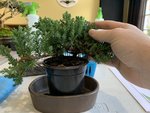TyroTinker
Shohin
This thread will be full of firsts. I welcome feedback and hope to learn from this little nana.
This juniper is from my first bonsai class. It was lead by a local who has only taught 2 other classes so far. It was a fun and I enjoyed getting out with others and cutting up some trees.
Class started with picking a pot and tree. Then we sat down at a table with our supplied tools already set out for us.

I picked up the tree with a larger trunk than most of the others and some movement in the trunk. I think all of the trees had that one long branch that made me think of a cascade style.
I’m not a big fan of cascading bonsai, unless it is a high level one. Which I think for my first trained tree might be out of my league. I grabbed a simple unglazed brown pot to go with it.
I grabbed a simple unglazed brown pot to go with it.






First thing we did is cut off all of the downward facing growth off of the branches and took out all the dead growth. At this point I completely forgot to take pictures until I was done cutting some branches and cleaning off my roots... oops
Here is the bottom of my pot right before I added a small amount of soil.

I was trying not to remove any roots but there was one thick one going straight down that I did take off. It didn’t have many fine roots on it. I thought it was strange that we were bare rooting a juniper in winter so I left all I could besides that. The root mass didn’t go all the way around the trunk so when I potted up the tree (with wire) I tried to keep the unrooted side with as much room to grow that I could. I’m not sure if that was the right choice or if I should have just put the open area closer to the edge of the pot and encouraged the roots that already existed.

Then I just spent a while trying to figure out what I wanted as a front and what angle to plant at. That natural cascade branch was really giving me some trouble. Wasn’t sure what to do with it.

I decided to keep that branch, but in the back as a hidden sacrifice branch. Or if I change my mind I still have it.
It does make a bar branch with a branch that I think is important to the front I did go with. I figure I have to make up my mind about my front soon, before the bar branch causes me any issues.
This juniper is from my first bonsai class. It was lead by a local who has only taught 2 other classes so far. It was a fun and I enjoyed getting out with others and cutting up some trees.
Class started with picking a pot and tree. Then we sat down at a table with our supplied tools already set out for us.

I picked up the tree with a larger trunk than most of the others and some movement in the trunk. I think all of the trees had that one long branch that made me think of a cascade style.
I’m not a big fan of cascading bonsai, unless it is a high level one. Which I think for my first trained tree might be out of my league.






First thing we did is cut off all of the downward facing growth off of the branches and took out all the dead growth. At this point I completely forgot to take pictures until I was done cutting some branches and cleaning off my roots... oops
Here is the bottom of my pot right before I added a small amount of soil.

I was trying not to remove any roots but there was one thick one going straight down that I did take off. It didn’t have many fine roots on it. I thought it was strange that we were bare rooting a juniper in winter so I left all I could besides that. The root mass didn’t go all the way around the trunk so when I potted up the tree (with wire) I tried to keep the unrooted side with as much room to grow that I could. I’m not sure if that was the right choice or if I should have just put the open area closer to the edge of the pot and encouraged the roots that already existed.

Then I just spent a while trying to figure out what I wanted as a front and what angle to plant at. That natural cascade branch was really giving me some trouble. Wasn’t sure what to do with it.

I decided to keep that branch, but in the back as a hidden sacrifice branch. Or if I change my mind I still have it.
It does make a bar branch with a branch that I think is important to the front I did go with. I figure I have to make up my mind about my front soon, before the bar branch causes me any issues.





















